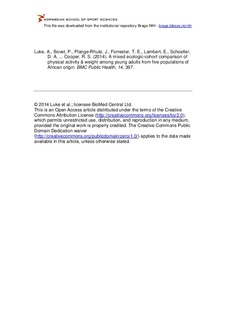| dc.contributor.author | Luke, Amy | |
| dc.contributor.author | Bovet, Pascal | |
| dc.contributor.author | Plange-Rhule, Jacob | |
| dc.contributor.author | Forrester, Terrence E. | |
| dc.contributor.author | Lambert, Estelle V. | |
| dc.contributor.author | Schoeller, Dale A. | |
| dc.contributor.author | Dugas, Lara R. | |
| dc.contributor.author | Durazo-arvizu, Ramon A. | |
| dc.contributor.author | Shoham, David A. | |
| dc.contributor.author | Cao, Guichan | |
| dc.contributor.author | Brage, Søren | |
| dc.contributor.author | Ekelund, Ulf | |
| dc.contributor.author | Cooper, Richard S. | |
| dc.date.accessioned | 2015-03-20T09:27:22Z | |
| dc.date.available | 2015-03-20T09:27:22Z | |
| dc.date.issued | 2014-04-24 | |
| dc.identifier.citation | BMC Public Health. 2014, 14, 397 | nb_NO |
| dc.identifier.uri | http://hdl.handle.net/11250/279928 | |
| dc.description | © 2014 Luke et al.; licensee BioMed Central Ltd. | nb_NO |
| dc.description.abstract | Background: Examination of patterns and intensity of physical activity (PA) across cultures where obesity prevalence varies widely provides insight into one aspect of the ongoing epidemiologic transition. The primary hypothesis being addressed is whether low levels of PA are associated with excess weight and adiposity.
Methods: We recruited young adults from five countries (500 per country, 2500 total, ages 25–45 years), spanning the range of obesity prevalence. Men and women were recruited from a suburb of Chicago, Illinois, USA; urban Jamaica; rural Ghana; peri-urban South Africa; and the Seychelles. PA was measured using accelerometry and expressed as minutes per day of moderate-to-vigorous activity or sedentary behavior.
Results: Obesity (BMI ≥ 30) prevalence ranged from 1.4% (Ghanaian men) to 63.8% (US women). South African men were the most active, followed by Ghanaian men. Relatively small differences were observed across sites among women; however, women in Ghana accumulated the most activity. Within site-gender sub-groups, the correlation of activity with BMI and other measures of adiposity was inconsistent; the combined correlation across sites was -0.17 for men and -0.11 for women. In the ecological analysis time spent in moderate-to-vigorous activity was inversely associated with BMI (r = -0.71).
Conclusion: These analyses suggest that persons with greater adiposity tend to engage in less PA, although the associations are weak and the direction of causality cannot be inferred because measurements are cross-sectional. Longitudinal data will be required to elucidate direction of association. | nb_NO |
| dc.language.iso | eng | nb_NO |
| dc.publisher | BioMed Central | nb_NO |
| dc.subject | physical activity | nb_NO |
| dc.subject | obesity | nb_NO |
| dc.subject | epidemiologic transition | nb_NO |
| dc.title | A mixed ecologic-cohort comparison of physical activity & weight among young adults from five populations of African origin | nb_NO |
| dc.type | Journal article | nb_NO |
| dc.type | Peer reviewed | nb_NO |
| dc.subject.nsi | VDP::Medical disciplines: 700::Health sciences: 800 | nb_NO |
| dc.source.journal | BMC Public Health | nb_NO |
| dc.description.localcode | Seksjon for idrettsmedisinske fag / Department of Sports Medicine | nb_NO |
